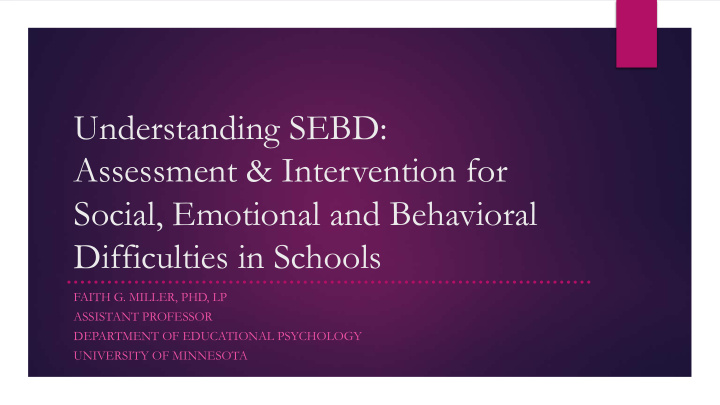



Understanding SEBD: Assessment & Intervention for Social, Emotional and Behavioral Difficulties in Schools FAITH G. MILLER, PHD, LP ASSISTANT PROFESSOR DEPARTMENT OF EDUCATIONAL PSYCHOLOGY UNIVERSITY OF MINNESOTA
Take a moment to respond to the following Rapid Poll question: All responses are anonymous – keep your browser open for next question – only up to 100 responses accepted
Take a moment to respond to the following Rapid Poll question: All responses are anonymous – keep your browser open for next question – only up to 100 responses accepted
Take a moment to respond to the following Rapid Poll question: All responses are anonymous – keep your browser open for next question – only up to 100 responses accepted
What’s in a name? Social, (School) Emotional, Behavioral (Student) Behavioral Health Mental Health Skills
Current status u Lifetime prevalence rates of DSM-IV mental disorders in a nationally- representative sample of adolescents were estimated at 49.5%, with 22% experiencing a mental disorder with severe impairment/distress (Merikangas, 2010). u The authors also found that the median age of disorder onset was 6 years for anxiety disorders, 11 for behavior disorders, and 13 for mood disorders. u These figures do NOT take into account subclinical problems. u One estimate suggests that 75-80% of children and youth in need of mental health services do not receive them (Kataoka, Zhang, & Wells, 2002).
Impact u Students who develop emotional and behavioral disorders experience among the poorest academic, social, and behavioral outcomes of any disability group (Kern, Hilt-Panahon, & Sokol, 2009). § Dropout rate >40% § Prior suspensions 44% § Had been arrested previously 60% (National Longitudinal Transition Study-2)
Impact
Prevention Science
“ Treatment without prevention is simply unsustainable. ” B ILL G ATES
Paradigm shift u The old way u The new way
Multi-Tiered Systems of Support (MTSS) MTSS RTI PBIS CI3T
MTSS Tier 3 Intensive (Few) • HELPS Reading Program Tier 2 Targeted (Some) • Reading Recovery Tier1 Universal (All Students) • Open Court Reading
MTSS SEBD Tier 3 Intensive (Few Students) • Individualized FBA-based Behavior Contract • Solution-Focused Counseling Tier 2 Targeted (Some Students) • Check-in/Check Out • Coping Power Tier 1 Universal (All Students) • Good Behavior Game • PATHS SEL Curriculum
State of the science Assessment Intervention u Early identification à Better u Evidence-based: outcomes u Universal supports (Tier 1) u Reliable and valid identification u Tier 2 supports practices u Tier 3 supports u Progress monitoring to inform problem-solving efforts
“ Perfect is the enemy of good. ” V OLTAIRE
Early identification u Precursors to severe problems u Students with SEBD are at greater risk for negative outcomes u By detecting problems early, we can ameliorate or mitigate negative outcomes
Intervention Data-based decision- making Assessment
Bruhn et al. (2014)
Miller et al., 2015 FALL RISK STATUS BY MEASURE 100 90 80 Proportion 70 60 50 40 30 20 10 0 School SSiS- SSiS- ODR BESS Nomination Prosocial Motivation At-risk 5 7 18 34 35 Not at-risk 95 93 82 66 65
Early identification u Consider what your building/district is doing to identify those students in need of additional SEB support u Must establish follow up procedures when identified at-risk u Supports must be available to address identified concerns u Build on existing efforts
Early intervention u Early identification à Foundation for early intervention u Change trajectory u Avoid a one-size-fits all approach: need-based u Evidence-based repositories u What Works Clearinghouse u National Registry of Evidence-based Programs and Practices (NREPP) u Development of feasible, contextually appropriate, effective school- based interventions
Mind powers “Powering up” Body Action powers powers
Bringing it all together u Consider conducting a needs assessment of your building/district with regard to SEB MTSS u Defined: A systematic process of asking questions, comparing answers, and making informed decisions about what to do next to improve human (and organizational) conditions and performance u Develop community/university partnerships
Growing Pains Be Better er performa mance
Bridge the gap u These efforts need a champion u Shared mission/beliefs/values u Ownership of SEB MTSS u Buy-in
A vision for the future
“ We cannot become what we want by remaining what we are. ” M AX D E P REE
Thank You! FAITH MILLER EMAIL: FGMILLER@UMN.EDU OFFICE: 612-625-0615
Recommend
More recommend